When people decide to write typical types of papers, they might need various guidelines to follow. Basically, the 7 types of academic writing include research papers, literature reviews, argumentative essays, descriptive essays, expository essays, personal reflections, and analytical essays. Hence, making sure that a student’s task can be addressed effectively is critical when it comes to writing. While the list of different works covered is never full, as teachers create new names for old ones each day, below is a basic description of the most popular types of papers among students. In turn, an entire description of these types of works is provided to show all people general information about each type of paper so that they understand them better.
What Are Types of Papers and Their Purposes
According to its definition, types of papers are documents that are classified in several forms, each serving distinct purposes within academic community, educational, and research landscapes. For example, research papers aim to investigate a specific question or topic, presenting original findings and analysis based on empirical evidence (Gupta et al., 2022). On the other hand, review papers synthesize existing literature, summarizing key developments and identifying gaps in knowledge to guide future research. Further on, argumentative papers present a thesis supported by evidence and reasoning, aiming to persuade readers of a particular viewpoint (Mentan, 2022). In writing, descriptive papers focus on detailing specific subjects or phenomena without providing personal opinions, often used in fields, like history or natural sciences. Then, analytical papers break down complex topics into their constituent parts, facilitating deeper understanding and critical thinking (Busse & August, 2020). In contrast, case studies explore particular instances in-depth, offering insights applicable to broader contexts. As such, each type of paper contributes to a collective knowledge of a discipline, fostering critical dialogue and advancing understanding in various fields (Heard, 2022). Besides, through these diverse formats, academic papers serve not only to communicate findings but also to stimulate inquiry, debate, and collaboration among students and scholars. Finally, by fulfilling these diverse purposes, they contribute significantly to an overall development of critical thinking and understanding across various disciplines (Bailey, 2022). In turn, the length of different types of papers depends on academic levels, institutional requirements, topics, and formats of writing, while general guidelines are:
High School
- Length: 1-5 pages
- Word Count: 250-1,250 words
College (Undergraduate)
- Length: 2-6 pages
- Word Count: 500-1,500 words
University (Bachelor’s Degree)
- Length: 3-7+ pages (for research papers, theses, and other types of works)
- Word Count: 750-1,750+ words
Master’s Degree (Program)
- Length: 4-8+ pages (for theses, dissertations, or other types of works)
- Word Count: 1,000-2,000+ words
Ph.D. (Doctoral Degree)
- Length: 8-20+ pages (for dissertations)
- Word Count: 2,000-5,000+ words
Types
| Type | Purpose |
|---|---|
| Research Paper | To investigate specific questions and present original findings and analysis. |
| Literature Review | To summarize and synthesize existing knowledge and research to provide an overview and identify literature gaps. |
| Research Proposal | To outline a planned study and detail a specific research question, methodology, and significance. |
| Narrative Essay | To tell a personal story and highlight significant experiences or events. |
| Descriptive Essay | To paint a vivid picture of a given subject and use detailed descriptions and sensory details. |
| Expository Essay | To explain facts and information about a specific topic in a structured format. |
| Argumentative Essay | To present arguments for or against a specific viewpoint supported by evidence. |
| Persuasive Essay | To convince readers to adopt a particular opinion or course of action. |
| Cover Letter | To introduce a job applicant and highlight his or her qualifications and interest in a chosen position. |
| CV (Curriculum Vitae) | To provide a comprehensive and clear overview of a person’s academic and professional background. |
| Resume | To summarize a job applicant’s skills, experience, and education in a concise format. |
| Admission Essay | To allow applicants to showcase their qualifications, experiences, and motivations for admission. |
| Personal Statement | To explore an individual’s background, motivations, and goals for academic applications. |
| Application Essay | To focus on specific prompts for college or job applications. |
| Personal Reflection and Response | To analyze personal experiences, response to specific topics, and enhance self-awareness. |
| Annotated Bibliography | To list academic and scholarly sources with summaries and evaluations and aid research on a topic. |
| Article Summary | To provide a brief overview of an article’s main ideas without personal opinions. |
| Rhetorical Analysis | To analyze how an author uses different rhetorical strategies, such as ethos, pathos, logos, kairos, and others, to achieve his or her purpose. |
| Book Review | To evaluate and critique a book and discuss its themes, characters, and effectiveness. |
| Movie Review | To analyze and critique a film and discuss its themes, performances, and impact. |
| Article Review | To evaluate and critique a specific article and discuss its contributions and limitations. |
| Artwork Review | To analyze and critique a piece of art and focus on its themes, techniques, and impact. |
| Event Review | To evaluate and reflect on a specific event and discuss its significance and outcomes. |
| Video Review | To critique a video and explore its content, effectiveness, and overall impact. |
| Memo | To communicate specific information internally within an organization. |
Prompts and Examples
Note: To see some samples of different types of papers, click on the links below:
- Exploring the Future of Renewable Energy Sources
- The Influence of Climate Change on Global Politics
- Potential Impact of Autonomous Vehicles on Urban Planning
- Cybersecurity Measures: Protecting Personal Data in the Digital Age
- Impacts of Technology on Society
- Influence of Violence in Video Games
- Narrative Techniques in “Lord of the Flies” by William Golding
- Effectiveness of Pain Management Techniques in Palliative Care
- Facebook’s Data Privacy Controversy: A Deep Dive
- Examining Metaphors in Martin Luther King Jr.’s “I Have a Dream”
Research Paper
There are mostly two types of a research paper:
Lengthy Types of Research Papers
A first one is usually associated with a lengthy essay structure that uses sources and is correctly formatted. For example, the 8 types of research papers include analytical, argumentative, expository, experimental, survey, case study, comparative, and descriptive compositions (Bailey, 2022). In writing, these compositions are usually seen in high schools, early college years, and sometimes in higher educational facilities that use this type of work instead of a regular essay. However, in such work, students are mostly asked to search the web for a potential answer to specific questions, learn how to take a side in discussions, how to present a personal position on a specific subject, and more.
Hence, a standard research paper is the most common type of writing that students deal with, and sometimes such a composition is even called an “essay” anyway because it is too common. For example, the different types of research papers include analytical, argumentative, expository, experimental, survey, case study, comparative, and descriptive papers, each serving unique purposes in an entire writing process (Heard, 2022). However, students usually do not know how to classify this type of paper and choose to write a standard essay to describe their topics because the main task here is to use outside sources and write a plagiarism-free composition that answers a specific question using those materials.
Serious Types of Research Papers or Dissertations
A second one is a serious research work that is associated with an expanded research paper, which can be in a form of a long dissertation. For example, such a type of document includes an abstract, outline, introduction, literature review, materials and methods, results, discussion, recommendations, limitations, conclusion, references, and appendix sections (Bailey, 2022). In writing, an experimental research paper reports on an investigation that tests a hypothesis through controlled experiments, detailing the methodology, data collected, results, and conclusions drawn from the findings. On the other hand, an analytical research paper examines a topic or issue by breaking a chosen subject down into its components, providing a detailed analysis of various aspects, and drawing conclusions based on evidence and reasoning.
Characteristics
Any research paper is an expanded essay and presents an author’s own interpretations, evaluations, and arguments. Moreover, this type of writing
Style
A research paper’s style is formal, uses impersonal and inclusive language, and covers a present tense to report well-accepted facts and a past tense to describe specific results. In turn, an entire writing of this type of document does not address a reader directly, does not use slang terms or superlatives, and includes only those figures necessary to presenting results.
Structure
A correct structure of a research paper is important because a well-structured docuemnt is easy to read and sounds professional. For example, writing well is never enough, and an entire structure of this type of an academic work makes a real difference (Bjorn et al., 2022). As a result, a common structure of a research paper is:
Title Page
A name of an entire work and a correctly formatted page will appear on a title page.
Abstract
An abstract page presents a summary of a whole work. For example, an abstract is a mix of introduction and conclusion parts, while this section should be written when a whole work is finished already (Bailey, 2022). In writing, such a part should describe all parts of a presented work, but, unlike a conclusion, this type may include a discussion about a purpose of an entire project.
Outline/Table of Contents
An outline or table of contents means a short structure of a whole work with highlighted major points of it. However, many people call such a part of work as a bone structure of a research paper.
Introduction
An introduction presents a rationale behind a presented work (background research), a description of its importance, a defending model, a brief description of an experimental design, highlighted research questions, and hypotheses.
Note: If you have any observations or ideas that came up before your experiment/research, you must write them in this section.
Literature Review
A literature review summarizes and synthesizes key arguments and ideas of others without adding new contributions. This type of work is organized around ideas, not around academic sources
Methods
A methods section documents key procedures and materials used, talks about sampling, and recognizes every aspect of your methods that can be used by others to repeat an entire study and to prove it if needed while also explaining how a given experiment will be conducted.
Results
A results section presents and illustrates the researcher’s findings and may include figures, charts, and tables.
Note: If you have any observations or ideas that came up during your experiment/research, you must write them in this section
Discussion
A discussion section is all about an entire interpretation of data, while any difference between expectations and results has to be explained in depth with reference to a study hypothesis and an overall outcome of an entire research.
Note: If you have any observations or ideas that came up after your experiment/research, you must write them in this section.
Limitations
If people find any limitations of their research that could affect their experiment/research so that other scholars can use such knowledge not to make the same mistakes, avoid contradicting results, and more, they must write them in this section.
Recommendations
If people have any recommendations on how to improve this research so that other scholars can use their recommendations, they must write them in this section.
Conclusion
This section is about final thoughts and a summary of a whole work. However, it is used instead of limitations and recommendations sections if the latter two sections are too small by themselves. Besides, no headings for recommendations and limitations sections are required in such cases.
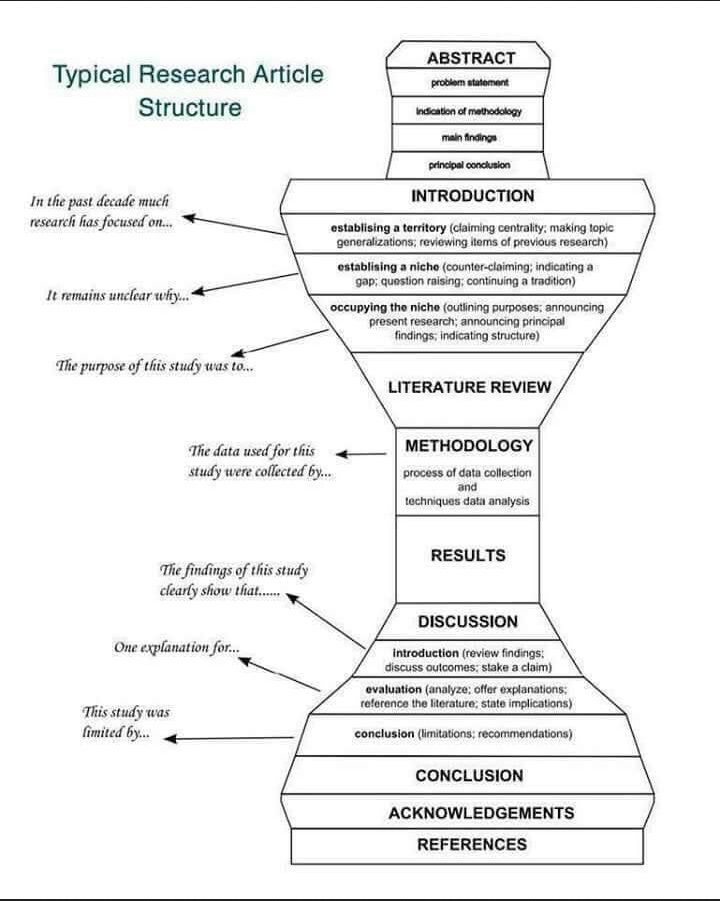
Literature Review
Below are the main aspects that concern one of the most important types of paper, which is a literature review.
Characteristics
A literature review type of work represents an entire evaluation of the information researched, particularly for a current investigation. For example, such evaluation relies on summary and interpretation of information (Heard, 2022). Additionally, a description of scientific works should give background information about a topic chosen and present a synthesis of the information in a chosen body of knowledge. However, a
Style
A literature review summarizes and synthesizes central arguments and ideas of others without adding new contributions. However, this type of work is organized around ideas, not academic sources themselves. Finally, it is not like an annotated bibliography would be organized.
Structure
Usually, a literature review is a part of a research paper, but it can be in a separate essay form. For example, literature reviews are written occasionally in the humanities but mostly in the sciences and social sciences (Bailey, 2022). In experiment and lab types of reports, they constitute a section of an entire paper. Furthermore, an overall structure of a literature review might vary from case to case because this type of work might be a simple summary of sources, represent a synthesis and additional research on an entire interpretation of literature, or be a part of a huge report.
However, when not a part of a research paper, such a section has an introduction, body, and conclusion. For example, an introduction is a quick recap of an overall theme of a paper that ends up with a thesis statement (Heard, 2022). A body of a literature review represents an entire discussion of sources in a chronological or thematic manner, while methodological patterns are also seen in some cases. Finally, conclusions and recommendations usually represent a direct answer to a “so what” question of why a literature review was conducted, whether a researcher achieved what was needed, and whether a researcher fulfilled expectations or not (Bailey, 2022). In turn, a conclusion must provide a recap of a literature review and restate a thesis.
Research Proposal
Research proposals might be different, but a main theme they follow includes an entire presentation of the background information of a specific gap in a specific topic and a proposal of how a researcher will solve such an issue. For example, an interpretative paper analyzes and explains an actual meaning of a specific text, artwork, or phenomenon, focusing on author’s or creator’s intentions and broader implications of an observed work (Heard, 2022). Hence, a research proposal type of work has to come up with some theoretical ways of filling a gap found by a researcher.
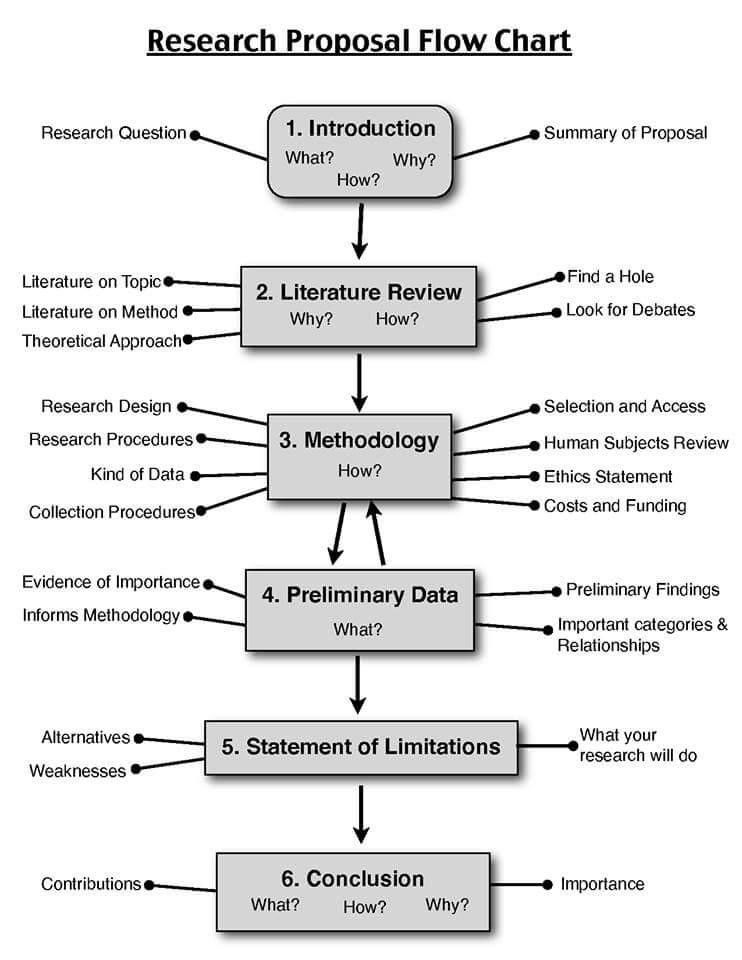
Narrative Essay
A narrative type of paper is always fun to write. Narratives appeared to be the best type of papers existing.
Characteristics
Creativity is a must because such type of work expresses something of importance and highlights specific aspects that influence one’s perception of reality or life in general.
Style
Narratives follow a first-person use and may include an appeal to reader’s emotions.
Structure
A narrative essay type of work should contain a short intro to a story, set a tone, and represent characters and settings. Besides, any story has to have a plot with a climax and a conclusion.

Narrative Essay Topic Examples
Descriptive Essay
Describe and reflect. Easy as that.
Characteristics
A descriptive paper paints a picture with words. Basically, such a composition might describe a place, an object, a person, an experience or something else and communicate a deeper meaning through a description. On the other hand, readers must have a clear impression of what a person describes.
Style
People need to use colorful words and sensory details and appeal to reader’s emotions and senses. This type of work also uses vivid language (tempestuous instead of violent, miserly instead of cheap).
Structure
People need to provide organized and logical descriptions.
Expository Essay
Expository essays are undercover.
Characteristics
An expository type of paper represents facts and auhtor’s explanation/definition of a short theme, idea or issue. It is also classified as informative writing.
Style
This type of paper is based on evidence and facts and never on personal feelings. For example, a definition paper explains a specific meaning of a chosen term or concept by providing a clear and concise description, often supported by examples, context, and analysis to enhance understanding. It represents concise points (Mentan, 2022). In writing, such a composition does not wander from a topic. Hence, students should never write in a first-person language or reveal personal emotions in this work.
Structure
An expository paper’s structure relies on an introduction, which must have a well-defined thesis, body paragraphs, and conclusion. For example, one body paragraph, as a rule, explains one general idea, while clear and logical transitions are a must (Mentan, 2022). In principle, a conclusion restates a thesis and readdresses it in light of the evidence provided. Moreover, such a type of paper can compare and contrast, provide examples, include definitions, and cover an analysis of cause and effect. In turn, a compare and contrast paper analyzes some similarities and differences between two or more topics or subjects, helping to highlight their relationships and distinctions in a structured manner.
Argumentative and Persuasive Types of Papers
Debatable topics will never be banished. Therefore, argumentation is important when one presents a personal viewpoint on a controversial subject.
Characteristics
The main goal is to do everything it takes to convince a reader of an author’s point of view, using facts and logic, examples, expert opinion, and sound reasoning. In turn, an author should represent all sides of an argument. However, such a type of paper must be able to communicate clearly why a certain position is right.
Style
In an argumentative type of essay, students are arguing for their opinion as opposed to others. In a persuasive essay, they are directly trying to persuade someone to adopt their point of view. Moreover, a good transition between paragraphs is important to make ideas clear (Mentan, 2022). In writing, people never overuse personal pronouns, even if it is not a mistake to use them here. As a result, they always try to remain impersonal in their writing.
Structure
All argumentative and persuasive types of papers start with an introduction that sets a unique context by reviewing a chosen topic in general, explains why this theme is important, and presents a clear, concise and defined thesis statement. Further on, body paragraphs include evidential support. In writing, one paragraph for one general idea is a rule to follow. Hence, each paragraph must have a logical connection to a thesis statement.
Each paragraph also explains why or how the evidence supports a thesis statement, while one or two of the paragraphs have to consider and explain differing points of view on a given topic and provide a counterargument with a refutation of why a counterargument is not valid in light of the evidence. It is important to make sure that only the line where an author’s argument is the only valid one follows a topic (Mentan, 2022). As a result, this type of paper ends with a conclusion that has to revisit a thesis statement, not simply restate it in other words, in light of the evidence provided. Finally, a common structure for such a type of paper is a five-paragraph approach, where there is 1 paragraph for an introduction, 3 paragraphs for a body of an essay, and 1 paragraph for a conclusion.
Personal Essays
Need to get into college? Need to get a job? Get it done!
Characteristics
These types of papers are usually referred to as application essays for students to an educational facility of choice. For example, such papers must include a generic autobiographical statement that usually portrays important information about a candidate (Mentan, 2022). However, life experiences, goals, and everything that makes a student special have to be identified in an essay. Additionally, a student, through an essay, speaks to a committee. By demonstrating specific skills and abilities that he or she might present to their community, it is for a student to win their attention and make sure they realize that he or she is the best candidate for a position of choice.
Students must identify a specific scope of interest, a background of how he or she got to it, and why an entire application to this education facility will accomplish a dream of a person to develop in this particular area of investigation. Finally, prospects might be mentioned at the end of such an application essay as it might be important for a committee to see if students want to pursue their path further or will stop by accomplishing a minor goal.
Style
Personal types of papers must capture a reader’s (committee’s) attention and show how an applicant stands out from other masses. In writing, a particular use of a first-person language will be a matter of choice in such an essay. Additionally, an author can appeal to a reader’s emotions, and that might be the best way to accomplish a dream of a successful application to a chosen university. Hence, such an
Structure
An application essay type of work has an introduction (grabbing a reader’s interest from the beginning), body, and conclusion.
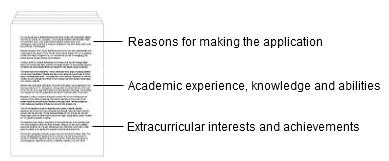
Application Letter Example
Personal Reflection and Response
Do you think you cannot write it on your behalf? Think twice!
Characteristics
This type of essay represents a person’s thoughts and opinions about something (movie, book, incident). It should be mostly about personal insights and observations.
Style
Such work uses a first-person language, own words, and explains how a person exactly perceive things.
Structure
This type of essay starts with an introduction with a thesis statement, continues with a body that narrates and describes a specific subject, and ends with a conclusion (includes judgment and summary).
Book or Movie Review
Such a lengthy type of work can be done without any issue!
Characteristics
A book or movie review represents an entire plot and its details and, at the same time, attract people’s attention to an item.
Style
These types of papers can provide personal points of view. Basically, a central task is not to prove something but to do a reasoned book/movie review, giving causes for reflections.
Structure
Authors start this type of work with an introduction and might include a thesis statement. Then, such a composition continues with a main body that represents some pieces of information about a reviewed aspect. On the other hand, people might present some findings on direction and production. As a rule, students provide a brief summary of a reviewed piece and find out a specific genre and its distinctive features embodied in a story. After all, an entire text ends with a conclusion (judgmental summary).
Annotated Bibliography
Need to go through tons of literature? Say no more!
Characteristics
An annotated bibliography is usually all about an entire list of sources with a summary and evaluation of each source, and such type of work is used for researching a topic. Depending on a chosen project, this type of work may contain one or more of the following: summary, assessment, comparison, and reflection (Bailey, 2022). Hence, a summary of a source includes main ideas, arguments, and key points. Additionally, an assessment relies on an overall evaluation of usefulness. In comparison with other sources, it also deals with a reliability of information and its objectiveness. However, reflection is all about how sources fit into a research project.
Style
These types of papers are usually written in a third-person langauge. However, a first-person language might be used in writing for evaluation-based annotations. As a result, author’s ideas have to be properly acknowledged, while an overall review has to be based on author’s implications and terms.
Structure
An annotated bibliography is always written in alphabetical order. For example, this type of work represents the list of annotations, which consists of the bibliographic information of a single source, being an appropriately cited source according to the paper formats’ rules (Heard, 2022). In writing, the majority of such works are written in MLA or APA formats, while an entire annotation in a paragraph form also has a specific structure that is identified as an academic standard. Moreover, other citation formats may include Chicago/Turabian or Harvard styles. Finally, an identified length is usually around 100-150 words, depending on instructions and parts required, which might exceed this limit.
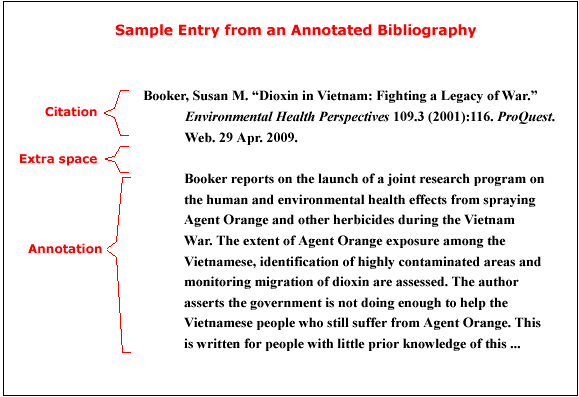
Article Summary
Reading articles and summarizing them cannot be a real challenge!
Characteristics
An article summary is a brief representation of main ideas of an observed source. Hence, this type of work identifies a source of an original text. Moreover, an entire writing always demonstrates an understanding of a text’s subject matter and focuses exclusively on a presentation of author’s main ideas. Finally, a
Style
A summary type of writing is neutral, without any personal opinion, ideas, illustrations, metaphors, or interpretation. Besides, summaries are normally written in people’s own words. As a result, they do not contain extended quotes or paraphrases, and they rely on a particular use of standard signal phrases that include but are not limited to “The author believes … ,” “according to the author … ,” and many more.
Structure
An article summary always starts with an introdocution that identifies a specific text to be summarized. For example, these types of papers usually talk about a specific title, an author, background information about an author, a date of publication, and other technical aspects of an observed source (Bailey, 2022). In this case, an entire writing might end with a one-sentence thesis statement that sums up a main point of a source. However, one or more body paragraphs should include important data but omit minor points. Besides, a body of summary might include one or more examples or illustrations. As a result, there is customarily no conclusion to a summary paper. Despite this, people never
Article, Artwork, Event, and Video Review
Do you need to watch or observe something? Not a problem at all.
Characteristics
Any review relies on both a summary and an evaluation of some articles, artworks, events, or videos. Firstly, students must summarize their subjects. Secondly, the important information, claims, and points have to be highlighted. Moreover, any type of review discusses some positive aspects of the information presented (Heard, 2022). Then, students have to think about what an author does well. However, within an essay, they have to identify contradictions, gaps, and inconsistencies in an observed subject. Finally, it is important to state how well an author defends his or her viewpoints, evaluating if there is enough data to say that. In turn, a review may highlight any gaps and limitations of a specific piece under analysis.
Style
During a writing process, it is important to remain impersonal and critical in any type of review. As a result, personal reflection is allowed.
Structure
As always, any type of paper starts with an introduction that identifies what a person is going to review, a work’s title, an author, a journal, a year of publication, and other important details or major aspects of a discussion. Further on, an introduction ends with a thesis statement. However, a body part includes a brief summary of key article’s contents and arguments (Bailey, 2022). Furthermore, students need to highlight a critical discussion of main problems raised in a chosen piece under analysis. After all, a conclusion represents a final evaluation of anoverall contribution to an entire understanding of a topic. Finally, some parts may talk about its importance on a broader scale.
Rhetorical Analysis
Ethos, Pathos, Logos, and Kairos – Remember these rhetorical devices!
Characteristics
A rhetorical analysis provides an overview of strategies an author uses to achieve his or her purpose of writing a piece. For example, a primary purpose may be different, which is: to inform, persuade, or criticize (Mentan, 2022). However, an entire analysis has to clearly understand a target audience. Further on, rhetorical appeals (ethos, logos, pathos, or kairos), style (diction or tone), and other literary strategies must be explained and discussed in an essay of this type. On the other hand, students have to identify whether author’s strategies are successfully applied. In turn, a rhetorical analysis might talk about rhetorical fallacies and possible biases.
Style
A rhetorical type of analysis incorporates strong verbs, such as praises, implies, lists, denigrates, defines, admonishes, contrasts, trivializes, warns, expounds, supports, and establishes among others) instead of weak verbs (tells, explains, states, says, or shows, for example).
Structure
This type of paper starts with an introduction that represents an author, an intended audience, and a purpose and ends with a thesis statement. Then, such a compositino continues with body paragraphs that are usually chronologically structured based on rhetoric strategies discussion. After all, a conclusion analyzes an overall effectiveness of author’s strategies.
Memo Types of Papers
Need to write a letter at work? Make it easy!
Characteristics
A memo type of paper is an internal business letter used to communicate in an organization. Basically, such a text is often written in a business setting and aims for a specific purpose. Moreover, memos are written to inform colleagues and employees of specific facts that concern everyone within a given organization.
Style
An entire writing has to be concise, formal, thorough, and clear.
Structure
TO: First Name Last Name, Position
FROM: First Name Last Name, Position
DATE: Month Day, Year
SUBJECT: Subject
A body of a memo. Attachments at the end of a memo.
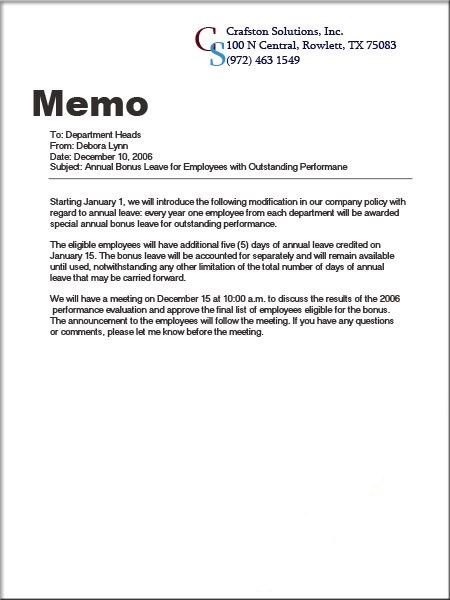
What to Include
| Element | Description |
|---|---|
| Hypothesis | A testable statement predicting a final outcome of a research study. |
| Thesis Statement | A central argument or claim an entire paper supports. |
| Research Questions | Specific inquiries that guide an overall investigation and analysis. |
| Data and Evidence | Quantitative or qualitative data that supports arguments and findings. |
| Case Studies | In-depth examinations of specific examples relevant to a chosen topic. |
| Visual Aids | Graphs, charts, or images that enhance understanding of the data presented. |
| Recommendations | Suggestions or propositions for future research or practical applications based on the findings. |
| Personal Reflections | Insights or personal commentary on a research process or topic. |
| Comparative Analysis | Examination of similarities and differences between studies, theories, or cases. |
| Citations | References to sources that support arguments or provide background information, formatted according to a style guide, such APA, MLA, Harvard, Chicago/Turabian, or any other. |
Common Mistakes
- Lack of a Clear Thesis: Failing to present a clear argument can leave readers confused about a paper’s type and purpose.
- Insufficient Research: Relying on a limited number of sources undermines an entire credibility of key arguments presented.
- Ignoring Formatting Guidelines: Not adhering to specified formatting styles, such as APA, MLA, Harvard, Chicago/Turabian, or any other, can detract from an overall professionalism of any type of paper.
- Poor Organization: A disorganized structure makes it difficult for readers to follow an argument or narrative.
- Overuse of Jargon: Excessive technical language can alienate readers who are not familiar with a presented topic.
- Inadequate Evidence: Making claims without sufficient supporting evidence weakens an overall argument.
- Plagiarism: Failing to properly cite academic and scholarly sources can lead to serious academic consequences.
- Weak Conclusion: A conclusion that simply restates points without synthesizing findings fails to provide closure.
- Grammar and Spelling Errors: Mistakes in grammar or spelling can undermine an author’s credibility and professionalism.
- Neglecting an Audience: Writing without considering a target audience’s background and knowledge can result in miscommunication.
Summing Up
There are various types of academic papers that serve distinct purposes. Basically, the 4 main types of academic papers are research papers, literature reviews, argumentative essays, and expository essays. In principle, research papers present findings and analyses based on original research, while literature reviews synthesize existing research to identify trends and gaps. Further on, research proposals outline planned studies, while narrative essays tell personal stories. In contrast, descriptive essays focus on vivid details, while expository essays explain topics based on facts. Moreover, argumentative and persuasive essays aim to convince readers of a specific viewpoint. In turn, additional types include personal reflections, reviews (books, movies, etc.), and annotated bibliographies, each tailored to specific academic needs. Finally, the 4 main styles of academic papers include APA, MLA, Chicago/Turabian, and Harvard, each with specific guidelines for citations and formatting.
References
Bailey, S. (2022). Academic writing for university students. Routledge.
Bjorn, G. A., Quaynor, L., & Burgasser, A. J. (2022). Reading research for writing: Co-constructing core skills using primary literature. Impacting Education: Journal on Transforming Professional Practice, 7(1), 47–58. https://doi.org/10.5195/ie.2022.237
Busse, C., & August, E. (2020). How to write and publish a research paper for a peer-reviewed journal. Journal of Cancer Education, 36(5), 909–913. https://doi.org/10.1007/s13187-020-01751-z
Gupta, S., Jaiswal, A., Paramasivam, A., & Kotecha, J. (2022). Academic writing challenges and supports: Perspectives of international doctoral students and their supervisors. Frontiers in Education, 7, 1–11. https://doi.org/10.3389/feduc.2022.891534
Heard, S. B. (2022). The scientist’s guide to writing: How to write more easily and effectively throughout your scientific career. Princeton University Press.
Mentan, T. (2022). English essay writing handbook. Authors’ Tranquility Press.
